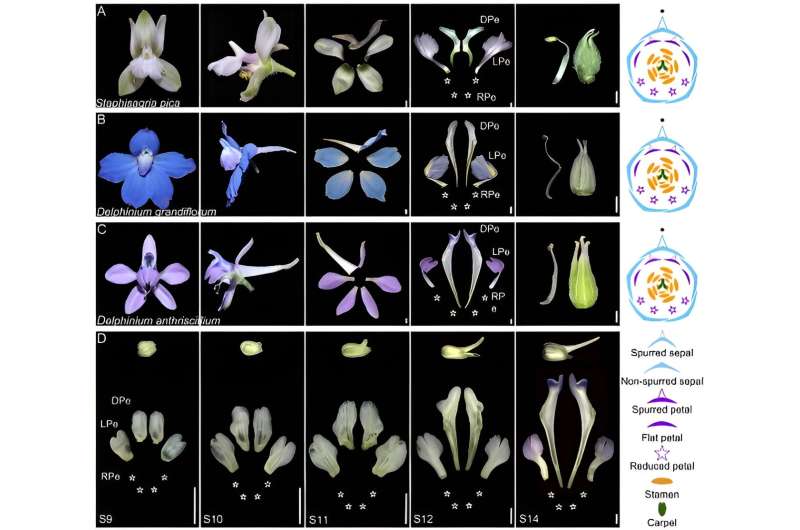This article has been reviewed according to Science X's editorial process and policies. Editors have highlighted the following attributes while ensuring the content's credibility:
fact-checked
peer-reviewed publication
trusted source
proofread
Study reveals key gene in Delphinium petal differentiation

A recent study investigated the role of the APETALA3–3 ortholog in shaping the diverse morphologies of petals in Delphinium anthriscifolium. This gene, previously known for its function in petal identity, is now revealed to be a key player in the intricate process of petal differentiation, offering a profound understanding of floral evolution and opening avenues for future botanical research and breeding innovations.
The genetic basis of floral diversity presents a significant challenge in plant biology. Delphinium, with its complex floral structures, serves as an excellent model for such investigations. While the foundational ABC model of flower development has provided insights, the mechanisms behind the formation of complex flowers remain largely unexplored.
Addressing these gaps requires a deep understanding of the genetic factors governing floral morphology in Delphinium. Consequently, there is a pressing need for comprehensive studies to uncover the genetic mechanisms controlling floral morphology and differentiation in these complex structures.
Researchers from Northwest A&F University have shed light on the genetic landscape of flowers, with their findings published in the Horticulture Research journal on April 9, 2024. The study explores the function of the APETALA3–3 ortholog in the morphological differentiation of Delphinium anthriscifolium petals.
The study employed a multi-faceted approach combining digital gene expression profiling, in situ hybridization, and virus-induced gene silencing to investigate the DeanAP3-3 gene. Initially, DeanAP3-3 showed uniform expression across all petal primordia.
As differentiation progressed, its expression varied, being highest in dorsal spurred petals, intermediate in lateral flat petals, and lowest in ventral reduced petals. Virus-induced gene silencing experiments demonstrated that reducing DeanAP3-3 expression caused significant morphological changes, with petals transforming into sepal-like structures based on the degree of silencing. Flowers with strong silencing showed complete petal-to-sepal transformation, while moderate silencing led to dorsal spurred petals becoming flat petals.
These results highlight DeanAP3-3's crucial role in both petal identity and morphological differentiation, revealing how expression levels influence final petal forms. This study advances our understanding of the genetic mechanisms underlying complex flower development in Delphinium anthriscifolium.
Dr. Liping Guo, one of the study's senior authors, remarked, "Our findings underscore the intricate relationship between gene expression levels and morphological outcomes in plant structures. DeanAP3-3 not only serves as a petal identity gene but also plays a pivotal role in defining the morphological characteristics of different petal types in Delphinium anthriscifolium."
The insights gained from this study are expected to contribute significantly to the field of ornamental horticulture, providing a genetic basis for breeding programs aimed at enhancing floral diversity and complexity. Furthermore, understanding the molecular mechanisms underlying petal differentiation can have broader implications for evolutionary biology and the study of gene function in other complex floral systems.
More information: Peng Zhang et al, Roles of the APETALA3–3 ortholog in the petal identity specification and morphological differentiation in Delphinium anthriscifolium flowers, Horticulture Research (2024). DOI: 10.1093/hr/uhae097
Journal information: Horticulture Research
Provided by NanJing Agricultural University




















